We sat down with Personal Trainer and Study Active assessor Louise to get her thoughts on barbell exercises and how to create a winning barbell workout.
Introduction to Barbell Workouts for Women
A common question we get all the time is what are the best barbell exercises for women? We think this is a very important area of fitness, so we reached out to Personal Trainer and Study Active tutor/assessor Louise Henderson to get her views on what makes a great women’s barbell workout. In this article Louise will share her views and experience and give her tips on things to consider when designing a women’s barbell workout routine. Over to you Louise!
IMPORTANT: The ideas in this article are purely for information only – please do not start an exercise programme until you have completed a PAR-Q and, if necessary, received medical clearance to train. It is important to always warm up and cool down and never to do any exercise that you are unsure of without the support and advice of a qualified professional.
What are some of the benefits to barbell workouts for women?
Weight training will boost metabolism which, in turn, burns calories and this is beneficial if your goal is weight loss. Muscle burns more calories than fat, but as you get older your metabolism tends to slow down due to age related muscle loss or atrophy. However, weight training can help to retain muscle mass thus, keeping metabolism elevated. This is important as weight loss can reduce the risk of long-term health conditions and chronic disease such as obesity, heart disease and diabetes.
Weight training can also increase mental health. When life gets tough it’s easy to quit, but weight training increases the ability to persevere – to push through the extra set or lift more weight when you feel you can’t do anymore.
Weight training will also increase bone density. Oestrogen is needed to help with bone grown, but during the menopause, oestrogen levels drop which can cause low bone density and osteoarthritis. If you already have low bone density, lifting weights can halt or even reverse the condition. Stronger bones can reduce the risk of fractures as well as increasing joint stability which may help reduce the risk of injury due to the increase strength and suppleness of tendons. One successful German study found that women gain an average of 11% bone mineral density in the hip after 3 years of strength training. (Engelke, K., Kemmler, W., Lauber, D. et al. 2006).
Finally, a barbell workout will improve your functional ability, balance, and coordination, making your ability to perform everyday tasks with ease.
What would you suggest for a beginner starting out incorporating barbell workouts into their training?
- Begin by practicing the exercise without the bar. Mastering the technique will reduce the risk of injury.
- Start light and increase the resistance as you get stronger.
- Focus on ‘the big 5’. According to Bonvechio, these 5 compound exercises are all you need
- Back Squat – one of the best barbell exercises for women, this exercise works major muscles such as quadriceps, glutes and hamstrings.
- Deadlift – a Women’s barbell workout routine would not be complete without the deadlift. Working the back and lower body muscles this is a firm favourite.
- Bench Press – Working the pectoral muscles this age-old exercise is a must for a women’s barbell workout routine
- Barbell Row – a great barbell exercise for women to strengthen back muscles
- Overhead Press – add this to a barbell workout for women to target the major upper body muscles
For fitness professionals seeking guidance on barbell training for women, CIMSPA offers resources and certifications to support your professional development.
Can you talk us through some barbell exercises you would recommend for the following. What might they look like?
- Barbell Squat – It’s best to use a squat rack in case you are unable to complete a rep. It also makes loading the bar onto your back easier and safer. Start with your feet shoulder width apart or slightly wider, rest the barbell on your upper back. Hold the bar with both hands facing forward - elbows pointing down. Activate your core as you bend your knees and sit back with your hips. Lower until your thighs almost reach parallel to the floor (or as low as you feel comfortable – maintain technique even if it means a shallower squat). Push through your whole foot as you return to the start position.
- Barbell Leg Workout - as a beginner I would recommend the following 3 exercises: Squat, deadlift, lunge. These exercises focus on the main muscles in the lower body: quadriceps, hamstrings, glutes, calves and can easily be progressed to keep you challenged once they become manageable. As a beginner who is looking to start building strength I would suggest 3 sets of 8-12 reps, ensuring that you reach muscle fatigue.
- Upper Body Barbell Workout - As I mentioned before, there are 5 compound exercises that I would recommend. Three of these will work your upper body. The main muscles worked in the bench press is the pectoralis, anterior deltoid, and triceps but when performed properly this exercise works far more muscles in the upper body and core. As well as strengthening the muscles in your back (lats, rhomboids, traps, rear delts) the barbell row helps to promote spine health and ‘trunk’ strength and stability. The overhead press is a great upper body exercise as it strengthens muscles in your deltoids (shoulders), pectorals (chest), triceps (arms) and trapezius (upper back)
If you’re a personal trainer looking to learn more about strength training for women, PT Cert offers specialized courses to enhance your expertise.
How would someone design a woman’s full body barbell workout? What format might that take?
I recommend ‘the big 5’ as these exercises are all compound lifts, meaning that they work multiple muscle groups at the same time. This means that instead of working a different muscle on each day, you can perform this workout 2-3 times per week. As I mentioned earlier, I would suggest a beginner starts with 3 x 8-12, working towards 5x5 (as the name suggests). Rest days are equally important, this gives the muscles time to repair and recover.
An example Women’s barbell workout routine could therefore be as follows:
|
Exercise |
Reps |
Sets |
Resistance |
Rest |
|
Barbell Squat |
10 |
3 |
75%1RM |
90 sec |
|
Barbell Chest Press |
10 |
3 |
75%1RM |
90 sec |
|
Barbell Deadlift |
10 |
3 |
75%1RM |
90 sec |
|
Barbell Row |
10 |
3 |
75%1RM |
90 sec |
|
Barbell Overhead Press |
10 |
3 |
75%1RM |
90 sec |
The above prescriptions are subjective to the individual, this is not a one size fits all. The actual reps, sets, intensity and rest used would be specific to the individual and based on what their goals are.
Teaching Points - Barbell Exercises for Women
It is of course imperative that these barbell exercises are performed correctly aby a female client. To ensure this is the case, we asked Personal Trainer and Study Active Assessor Kelly-Anne O-Regan to run us through some teaching points for the five barbell exercises that we have discussed in this article.
Barbell Squat for Women
N.B – Before performing this squat, it is important that you can perform a bodyweight squat, progressing to a weighted squat i.e goblet squat, with good technique, before progressing to the barbell back squat.
- Ensure weight load is distributed evenly and weight is appropriate for your level and needs. Start light if new to this exercise.
- Approach bar on the squat rack, ensuring the midline of your body is middle with the bar to ensure that even distribution.
- Rest bar across the shoulders (not the neck), take grip of the bar, palms facing forwards, even width, wrists straight.
- Feet shoulder width apart (or just wider), toes pointing slightly outwards.
- When ready and comfortable, stand up straight, knees soft, taking the weight of the bar, taking a step back away from the rack.
- Engage core, then slowly squat down, taking hips back, bum out. Ensure knees follow the direction of your toes, keep weight to your heels (dig heels to floor).
- Keep facing forwards, chest up. Squat to where your hip flexibility will take you, but overall aim is to get your thighs parallel to the floor. However this can be achieved over time.
- Keep movement slow and controlled, core engaged at all times to protect the spine.
- Return to start position by standing tall, chest high, looking forwards, keep knees soft (not locked). Repeat for desired reps.
- BREAHTHING – Breathe in on the downward phase and out on the upwards phase (effort).
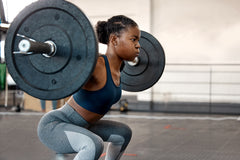
Barbell Chest Press for Women
N.B – Do not attempt to lift any unfamiliar or heavy weight without a spotter present. It is always advised to start light until comfortable and can perform with good technique.
- Lie flat on the bench, feet firmly on the floor. Ensure back and spine are in neutral alignment, keep core engaged.
- Take hold of bar from the spotter with a wide grip (wider than body width), palms facing forwards, wrists straight.
- Arms extended (elbows not locked), bar should be level with the chest.
- Slowly lower the bar ensuring not to take the elbows too wide, to just above the chest (not resting on the chest). Then press up in one controlled and smooth movement.
- BREATHING – In on the downward phase, out on the press (effort) phase.
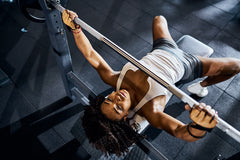
Barbell Deadlift for Women
- Stand with feet under the barbell, shoulder width apart, toes pointing slightly outwards.
- Bend down taking hips back (bum out), bending at the knees. Take hold of the bar with an overhand grip (outside of the legs), ensuring even width and distribution.
- Look approximately 45 degrees in front (not down at the floor, but not straight ahead), and keep chest up, shoulders back with core engaged.
- With a firm grip and keeping the bar close to the shins/body, take ‘slack’ out of bar by pulling to ensure the bar is under tension.
- Begin to lift the bar by standing tall with the legs, pushing the floor away and not pulling with the arms.
- Once the bar has cleared the knees, hinge hips forwards allowing you to stand tall while maintaining the bar close to the body, squeezing the glutes at the top of the movement.
- Ensure you keep your heels to the ground which takes the weight and pressure off the knees and the spine in a neutral position throughout the whole lift.
- Return to start position slowly in the reverse sequence of above.
- BREATHING – Breathe out on the upwards phase (effort), in on the downward phase.
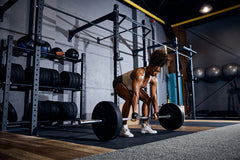
Barbell Upright Row for Women
- Stand feet shoulder width apart. Take hold of the bar in a deadlift position, with a narrow overhand grip (to measure, you can spread your thumbs out so they slightly touch). Ensure even distribution either side of the bar. N.B This can also be performed taking a wider hand grip i.e wider than body width, which would target more of the upper back muscles.
- Safely deadlift the bar so you are stood up straight. Keep core engaged, maintain neutral spine, facing forwards, bar close to the body.
- Slowly raise the elbows/arms to bring the bar just below the chin (or where flexibility allows), ensuring the bar stays close to the body and elbows stay higher than the wrist.
- Slowly bring the bar back down to the starting position.
- BREATHING – Breath out on the upwards (effort) phase, in on the downwards phase.
- Movement should be slow and controlled, repeat for desired number of reps.
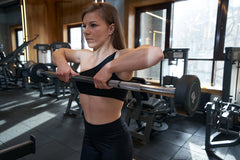
Barbell Overhead Press for Women
N.B - Do not attempt to lift any unfamiliar or heavy weight, it is always advised to start light until comfortable and can perform with good technique.
This exercise can also be performed in a seated position, which could provide support for the back.
- Approaching the rack (bar should be level with the chest), take an overhand grip of the bar (knuckles up), positioning hands wider than shoulder width, elbows tucked in, ensuring even distribution either side of the bar. If taking the bar from the floor, you will need to safely deadlift and clean the bar into the correct starting position to chest height.
- Safely life the bar off the rack, keeping bar near the chest.
- Take a step back away from the rack, ensuring feet are shoulder width apart, core is engaged and that you are looking forwards, spine is in neutral alignment.
- In one smooth movement, press the bar above the head, ensuring that you move you head back slightly to avoid your face coming into contact with the bar. Keep arms straight, but elbows not locked.
- Slowly bring bar back to the starting position to just above your chest.
- BREATHING – Breath out on the pressing (effort) phase, in on the downwards phase.
- Movement should be controlled at all times. Repeat for desired number of reps.
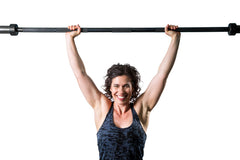
Summary - Barbell Workout for Women
Thank you, Louise and Kelly-Anne for your insights and suggestions on barbell workouts for women. There are many benefits to incorporating barbell exercises into your workout and a range of exercises can be utilised to focus on different areas or provide a full body workout. For a similar blog with more exercises please see our article The Best Arm Workout for Women
Barbell exercises for women are something that is increasingly asked for within the fitness sector. This is why a good PT should be well equipped with the knowledge to design a women’s barbell workout. It is important that a PT considers the client and applies the relevant knowledge to design and deliver a women’s barbell workout routine.
Incorporating barbell exercises such as the squat and bench press ensure that major muscles are targeted which will see increases in strength and hypertrophy if the correct exercise principles are applied. The squat is certainly a highly recommended barbell exercise for women however a workout could also target the same muscles by using exercise machines such as the leg press or leg extension.
For information on our Personal Trainer Courses please click here
Article by Kari Fry with Louise Henderson.







